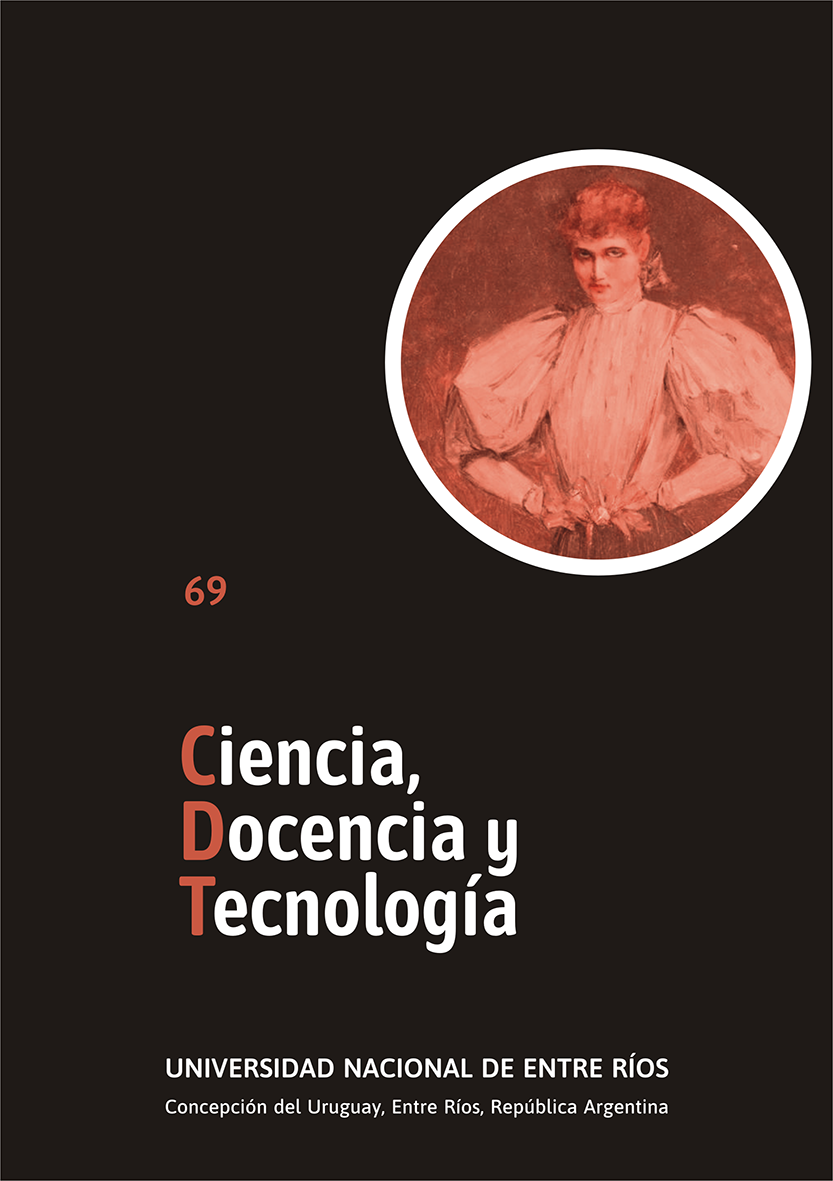Misoprostol as an abortion drug: the co-construction process of its posology
DOI:
https://doi.org/10.33255/3469/1624Keywords:
Misoprostol, abortion, posology, biomedical technologiesAbstract
Currently, misoprostol is the drug recommended by the World Health Organization for safe and ambulatory abortions. In this article we will explore the controversy surrounding the process of co-construction of its indications as an abortifacient drug in Argentina during the 2000s. Unlike other Latin American countries, its first uses as a contractile inducer in the field of gastroenterology had not been recognized for this type of practice. We propose a diversified methodological strategy that incorporates not only the discourses, but also the practices of those who were involved in the period analyzed from the analysis of written sources and in-depth interviews. Starting from a problematization of the search for an effective dosage of misoprostol from the perspective of the social construction of technology, we propose a series of discussions around scientific evidence and indications by health professionals, women who used the medication and the feminist movement. Unlike the analytical proposal of linear visions of technological innovation, in this article we investigate the centrality of these actors during the decade analyzed in the controversy surrounding an effective posology of misoprostol as an abortion drug.
Downloads
References
ARIZA, L. (2010). La procreación como evento natural o tecnológico: Repertorios decisorios acerca del recurso a la reproducción asistida en mujeres en parejas infértiles de Buenos Aires. EA, 2(1), 1-47.
ARIZA, L. (2014). Fotografías, registros médicos y la producción material del parentesco: Acerca de la coordinación fenotípica en la reproducción asistida en Argentina. En A. Cepeda & C. Rustoyburu (Eds.), De las hormonas sexuadas al Viagra: Ciencia, medicina y sexualidad en Argentina y Brasil (pp. 173-206). EUDEM.
ARIZA, L. (2015). Keeping Up Appearances in the Argentine Fertility Clinic. TECNOSCIENZA, 6(1), 5-31.
ARIZA, L. (2016). Cuerpos abstractos, riesgos concretos: Dispositivos clínicos y la salud de las donantes de óvulos en la medicina reproductiva argentina. Salud Colectiva, 12(3), 361-382. https://doi.org/10.18294/sc.2016.789
ARIZA, L. (2017). La regulación de las tecnologías reproductivas y genéticas en Argentina: Análisis del debate parlamentario. Cadernos Pagu, 50. https://doi.org/10.1590/18094449201700500005
ASOCIACIÓN POR LOS DERECHOS CIVILES (2013). Aborto no punible. El fallo FAL s/ medida autosatisfactiva. ¿Qué obtuvimos y que nos queda por obtener? (p. 53). Asociación por los derechos civiles.
ASOCIACIÓN POR LOS DERECHOS CIVILES (2015). Acceso al aborto no punible en Argentina: Estado de situación (p. 81). Asociación por los Derechos Civiles.
AVRECH, O. M. (1991). Mifepristone (RU486) alone or in combination with a prostaglandin analogue for termination of early pregnancy: A review. Fertility and Sterility, 56, 385-393.
BELLUCCI, M. (2014). Historia de una desobediencia: Aborto y feminismo. Capital Intelectual.
BIJKER, W. (2008). La construcción social de la baquelita: Hacia una teoría de la invención. En H. Thomas y A. Buch (eds.), Actos, actores y artefactos. Sociología de la tecnología (pp. 63-100). UNQUI.
BLANCHARD, K. (2002). Misoprostol for women’s health: A review. Obstetrics & Gynecology, 99(2), 316-332. https://doi.org/10.1016/S0029-7844(01)01701-X
BURTON, J. (2017). Prácticas feministas en torno al derecho al aborto en Argentina: Aproximaciones a las acciones colectivas de Socorristas en Red. Revista Punto Género, (7), 91-111. https://doi.org/10.5354/0719-0417.2017.46268
CARBONELL ESTEVE, J. L.;Varela, L.;Velazco, A.;Cabezas, E.;Tanda, R.y Sánchez, C. (1998). Vaginal misoprostol for late first trimester abortion. Contraception, 57(5), 329-333. https://doi.org/10.1016/S0010-7824(98)00037-7
CARVALLO, M. (2011). Inaccesibilidad al aborto no punible en la Argentina: Obstáculos de IURE y obstáculos de FACTO. Cuestión de Derechos, 1, 45-57.
CLARKE, A.y Montini, T. (1993). The Many Faces of RU486: Tales of Situated Knowledges and Technological Contestations. Science, Technology& Human Values, 18(1), 42-78. https://doi.org/10.1177/016224399301800104
COLLINS, H. (1975). Los siete sexos: Estudio sociológico de un fenómeno, o la replicación de los experimentos en física. En I. Iranzo, Sociología de la Ciencia y la Tecnología. CSIC.
COLLINS, H., y Pinch, T. (2010). The golem: What you should know about science (2. ed., 12. print). Cambridge Univ. Press.
DAVID, H. P. (1992). Acceptability of Mifepristone for Early Pregnancy Interruption. Law, Medicine and Health Care, 20(3), 188-194. https://doi.org/10.1111/j.1748-720X.1992.tb01187.x
DE LAURETIS, T (1987). Technologies of gender: Essays on theory, film, and fiction. Indiana University Press.
DELLACASA, M. (2017). Dimensiones políticas de las tecnologías corporales en personas trans. Avá, 31, 73-96.
DELLACASA, M. (2020). Personas trans y procesos de tecnificación de la existencia. Apropiaciones e innovaciones en torno al uso de artefactos. Cuestiones de género: de la igualdad y la diferencia, 15, 209-228. https://doi.org/10.18002/cg.v0i15.6177
DROVETTA, R. I. (2014). Acciones feministas en las Líneas de Información Aborto Seguro (LIAS) en Latinoamérica y el Caribe. En A. Carosio (ed.), Feminismos para un cambio civilizatorio. Fundación Celarg, CLACSO, Centro de Estudios de la Mujer.
ELUL, B.;Ellertson, C.;Winikoff, B.yCoyaji, K. (1999). Side effects of mifepristone-misoprostol abortion versus surgical abortion. Contraception, 59(2), 107-114. https://doi.org/10.1016/S0010-7824(99)00003-7
FAUSTO-STERLING, A. (2000). La política de género y la construcción de la sexualidad. Melusina.
FELITTI, K. (2012). La revolución de la píldora: Sexualidad y política en los sesenta. Edhasa.
FOX KELLER, E. (1982). Feminism and Science. Signs, 7(3), 589-602.
FRANCHI, A. M. (2019). Las mujeres y la ciencia: Obstáculos y desafíos para lograr la equidad de género. Ciencia, Tecnología y Política, 2(3), 38-45. https://doi.org/10.24215/26183188e026
GROSSO, B., Trpin, M., y Zurbriggen, R. (2013). Políticas de y con los cuerpos: Cartografiando los itinerarios de Socorro Rosa (un servicio de acompañamiento feminista para mujeres que deciden abortar) [Electronic resource]. En A. M. Fernández & W. S. Peres (Eds.), La diferencia desquiciada: Géneros y diversidades sexuales (pp. 97-120). Editorial Biblos.
HARAWAY, D. (1991). Ciencia, cyborgs y mujeres. Ediciones Cátedra, Univerdidad de Valencia.
HARDING, S. (1993). Ciencia y Feminismo. Morata.
HARPER, C. C.;Blanchard, K.;Grossman, D.;Henderson, J. T. y Darney, P. D. (2007). Reducing maternal mortality due to elective abortion: Potential impact of misoprostol in low-resource settings. International Journal of Gynecology & Obstetrics, 98(1), 66-69. https://doi.org/10.1016/j.ijgo.2007.03.009
KIPRIZLIAN, A.;López Méndez, S.;Scaravonati, H.;Campos, L. y Gómez, E. (2008). Aborto. Un mal en nuestra sociedad que no pierde vigencia. Revista de la Sociedad de Obstetricia y Ginecología en la Provincia de Buenos Aires, 39(206), 83-89.
KLINE, S. J. (1985). Innovation Is Not a Linear Process. Research Management, 28(4), 36-45. https://doi.org/10.1080/00345334.1985.11756910
KNORR CETINA, K. (2005). La fabricación del conocimiento: Un ensayo sobre el carácter constructivista y contextual de la ciencia (1. ed). Universidad Nacional de Quilmes.
LAFAURIE, M. M.;Grossman, D.;Troncoso, E.;Billings, D. L. y Chávez, S. (2005). Women’s Perspectives on Medical Abortion in Mexico, Colombia, Ecuador and Peru: A Qualitative Study. Reproductive Health Matters, 13(26,), 75-83.
LATOUR, B. (2008). Reensamblar lo social: Una introducción a la teoría del actor-red. Manantial.
LATOUR, B. y Woolgar, S. (1979). La vida en el laboratorio. La construcción de los hechos científicos. Alianza.
LAW, J. (2004). After method: Mess in social science research. Routledge.
LEDESMA, M. A.;Gorostiaga, B. N.;Folla, M. A.y Acha, M. J. (2005). Aborto séptico. Obstetricia y Ginecología Latinoamericanas, 4, 165-169.
MAHAJAN, D. K. y London, S. N. (1997). Mifepristone (RU486): A review. Fertility and Sterility, 68(6), 967-976. https://doi.org/10.1016/s0015-0282(97)00189-1
MATEO, N. (2022). La construcción social del misoprostol en el laboratorio: De su inscripción como protector gástrico a su reconstrucción como fármaco abortivo. Revista Redes, 55, 1-28.
MINISTERIO DE SALUD DE LA NACIÓN (2007). Guía técnica para la atención integral de los abortos no punibles.
MINISTERIO DE SALUD DE LA NACIÓN. (2010). Guía técnica para la atención integral de los abortos no punibles.
MORGAN, L. M. (2019). Reproductive Governance, Redux. Medical Anthropology, 38(2), 113-117. https://doi.org/10.1080/01459740.2018.1555829
NOGUÉS, G. (2018). Pensar con otros. Una guía de supervivencia en tiempos de posverdad. El Gato y la Caja.
NORMAN, J. E.;Thong, K. J. y Baird, D. T. (1991). Uterine contractility and induction of abortion in early pregnancy by misoprostol and mifepristone. The Lancet, 338, 1233-1236.
OUDSHOORN, N. (1994). Beyond the Natural Body: An Archeology of Sex Hormones. RoutLedge.
OUDSHOORN, N. (1998). Hormones, technique et corps. L’archéologie des hormones sexuelles (1923-1940) (G. Morel, trad.). Annales. Histoire, Sciences Sociales, 53(4), 775-793. https://doi.org/10.3406/ahess.1998.279697
OUDSHOORN, N.yPinch, T. (eds.). (2003). How users matter: The co-construction of users and technologies. MIT Press.
PEYRON, R.;Aubeny, E.;Targosz, V.;Silvestre, L.;Renault, M.;Elkik, F.;Leclerc, P.;Ulmann, A. y Baulieu, E.-E. (1993). Early Termination of Pregnancy with Mifepristone (RU 486) and the Orally Active Prostaglandin Misoprostol. New England Journal of Medicine, 328(21), 1509-1513. https://doi.org/10.1056/NEJM199305273282101
PINCH, T. (1997). La construcción social de la tecnología: Una revisión. En M. J. Santos y R. Díaz Cruz, Innovación tecnológica y procesos culturales. Fondo de Cultura Económica.
PINCH, T. y Bijker, W. (1987). La construcción social de los hechos y de artefactos: O acerca de cómo la sociología de la ciencia y la sociología de la tecnología pueden beneficiarse mutuamente. En H. Thomas y A. Buch, Actos, actores y artefactos. Sociología de la tecnología (pp. 19-62). UNQUI.
ROCA, A., y Dellacasa, M. (2015). Tecno redéncion de cuerpos transexuales: Apropiación tecnológica y autogestión de identidades inconclusas. Mediações - Revista de Ciências Sociais, 20(1), 239-259. https://doi.org/10.5433/2176-6665.2015v20n1p239
RUSTOYBURU, C. (2020). Los implantes subdérmicos como tecnologías anticonceptivas para adolescentes. Un estudio de su implementación en la ciudad de Mar del Plata (Buenos Aires, Argentina). Argumentos. Revista de crítica social, 22, 318-340.
RUSTOYBURU, C. (2021). Storytime sobre implantes anticonceptivos en YouTube. Disputas de significados y relaciones biomédicas en las narrativas de youtubers latinoamericanas. Historia y sociedad, 40, 224-242. https://doi.org/10.15446/hys.n40.86918
RUSTOYBURU, C., & Mateo, N. (2020). Tecnologías de la (no) reproducción: Discursos médicos sobre el implante subdérmico en jóvenes de sectores populares en Argentina. En R. Cicerchia, M. del P. M. Haydar, F. García González, & C. Rustoyburu (Eds.), El estudio de las formas familiares en el nuevo milenio: Trayectos, dilemas y propuestas. Prohistoria Ediciones.
RUSTOYBURU, C., y Ariza, L. (2022). Autonomy in Austerity Times. Examining Hormonal Contraceptive Implants in Argentina. Medical Anthropology, 1-16.
SCHAFF, E. A.;Eisinger, S. H.;Stadalius, L. S.;Franks, P.;Gore, B. Z. y Poppema, S. (1999). Low-dose mifepristone 200 mg and vaginal misoprostol for abortion. Contraception, 59(1), 1-6. https://doi.org/10.1016/S0010-7824(98)00150-4
TÁVARA, L.;Chávez, S.;Grossman, D.;Lara, D. y Blandón, M. (2008). Disponibilidad y uso obstétrico del misoprostol en los países de América Latina y el Caribe. Revista Peruana de Obstetricia y Ginecologia, 54(4), 253-263.
THONG, K. J.yBaird, D. T. (1992). Induction of abortion with mifepristone and misoprostol in early pregnancy. BJOG: An International Journal of Obstetrics and Gynaecology, 99(12), 1004-1007. https://doi.org/10.1111/j.1471-0528.1992.tb13707.x
VÁZQUEZ, S. y Szwarc, L. (2018). Aborto medicamentoso. Transferencias militantes y transnacionalización de saberes en Argentina y América Latina. RevIISE, 12(12), 163-177.
VÁZQUEZ, S.;Gutiérrez, M. A.;Calandra, N. y Berner, E. (2006). El aborto en la adolescencia. Investigaciones sobre el uso de misoprostol para la interrupción del embarazo en adolescentes. En S. Checa, Realidades y coyunturas del aborto: Entre el derecho y la necesidad. Paidós.
VELAZCO BOZA, A.;Gómez Ponce de León, R.;Salas Castillo, L.;Yi Mariño, D. R. y Mitchell, E. M. H. (2008). Misoprostol Preferable to Ethacridine Lactate for Abortions at 13–20 Weeks of Pregnancy: Cuban Experience. Reproductive Health Matters, 16(sup31), 189-195. https://doi.org/10.1016/S0968-8080(08)31392-5
VELAZCO, A.;Varela, L.;Tanda, R.;Sánchez, C.;Barambio, S.;Chami, S.;Valero, F.;Aragón, S.;Marí, J. y Carbonell, J. L. L. (2000). Misoprostol for abortion up to 9 weeks’ gestation in adolescents. The European Journal of Contraception & Reproductive Health Care, 5(4), 227-233. https://doi.org/10.1080/13625180008500410
WAJCMAN, J. (1991). Feminism Confronts Technology. Pennsylvania State University.
WAJCMAN, J. (2006). El tecnofeminismo. Ediciones Cátedra.
ZORDO, S. D. (2016). The biomedicalisation of illegal abortion: The double life of misoprostol in Brazil. História, Ciências, Saúde-Manguinhos, 23(1), 19-36. https://doi.org/10.1590/S0104-59702016000100003
ZORDO, S. D. (2016). The biomedicalisation of illegal abortion: The double life of misoprostol in Brazil. História, Ciências, Saúde-Manguinhos, 23(1), 19-36. https://doi.org/10.1590/S0104-59702016000100003
Published
How to Cite
Issue
Section
License
Copyright (c) 2023 Natacha Mateo

This work is licensed under a Creative Commons Attribution-NonCommercial-ShareAlike 4.0 International License.
The authors retain the copyright and grant the journal the right to be the first publication of the work, as well as licensing it under a Creative Commons Attribution License that allows others to share the work with an acknowledgment of the authorship of the work and publication initial in this magazine. All content is published under the Creative Commons 4.0 international license: Attribution-Non-Commercial-Share Alike.






